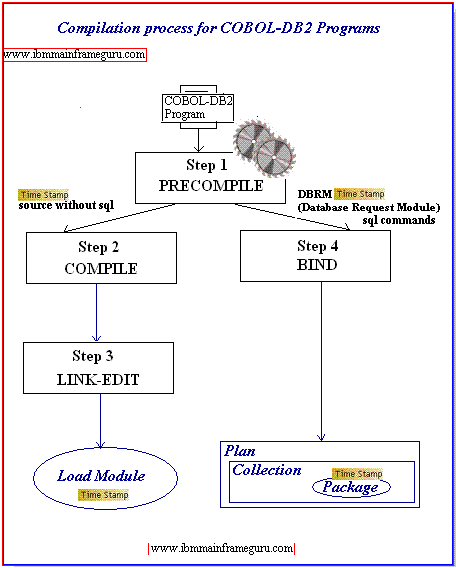Cobol Db2 Compile Jcl Program
Compiling COBOL Programs In order to execute a COBOL program in batch mode using JCL, the program needs to be compiled and a load module is created with all the sub-programs. The JCL uses the load module and not the actual program at the time of execution.
The load libraries are concatenated and given to the JCL at the time of execution using JCLLIB or STEPLIB. There are many mainframe compiler utilities available to compile a COBOL program. Some corporate companies use Change Management tools like Endevor, which compiles and stores every version of the program.
This is useful in tracking the changes made to the program. //COMPILE JOB,CLASS=6,MSGCLASS=X,NOTIFY=&SYSUID //* //STEP1 EXEC IGYCRCTL,PARM=RMODE,DYNAM,SSRANGE //SYSIN DD DSN=MYDATA.URMI.SOURCES(MYCOBB),DISP=SHR //SYSLIB DD DSN=MYDATA.URMI.COPYBOOK(MYCOPY),DISP=SHR //SYSLMOD DD DSN=MYDATA.URMI.LOAD(MYCOBB),DISP=SHR //SYSPRINT DD SYSOUT=* //* IGYCRCTL is an IBM COBOL compiler utility. The compiler options are passed using PARM parameter.
In the above example, RMODE instructs the compiler to use relative addressing mode in the program. The COBOL program is passed using SYSIN parameter and the copybook is the library used by the program in SYSLIB. Coach Dsc Driver Windows 7. This JCL produces the load module of the program as output which is used as the input to the execution JCL.
Running COBOL Programs Below a JCL example where the program MYPROG is executed using the input file MYDATA.URMI.INPUT and produces two output files written to the spool. //COBBSTEP JOB CLASS=6,NOTIFY=&SYSUID // //STEP10 EXEC PGM=MYPROG,PARM=ACCT5000 //STEPLIB DD DSN=MYDATA.URMI.LOADLIB,DISP=SHR //INPUT1 DD DSN=MYDATA.URMI.INPUT,DISP=SHR //OUT1 DD SYSOUT=* //OUT2 DD SYSOUT=* //SYSIN DD * //CUST1 1000 //CUST2 1001 /* The load module of MYPROG is located in MYDATA.URMI.LOADLIB.
This is important to note that the above JCL can be used for a non-DB2 COBOL module only. Passing Data to COBOL Programs Data input to COBOL batch program can be through files, PARAM parameter and SYSIN DD statement.
In the above example: • Data records are passed to MYPROG through file MYDATA.URMI.INPUT. This file will be referred in the program using the DD name INPUT1. The file can be opened, read and closed in the program.

Ibm mainframe jcl utilitites and compile run jcl for vs cobol ii, ibm cobool, rexx, cics, db2, db2 cics, rexx, pl/1 - ibmmainframes.com. Running COBOL programs using JCL. This is useful in tracking the changes made to the program. //COMPILE JOB,CLASS=6,MSGCLASS. For running COBOL DB2 program. Pre compile, Compile and Link JCL for COBOL DB2 Program. ReUsable Compile & Run JCL Codings. Compiler and Run JCLs for VS COBOL II, IBM COBOL, CICS, DB2, PL/I. REXX INTERPRETER JCL: REXX PROGRAM WITH RUN COMMAND.
• The PARM parameter data ACCT5000 is received in the LINKAGE section of the program MYPROG in a variable defined within that section. • The data in the SYSIN statement is received through ACCEPT statement in the PROCEDURE division of the program. Every ACCEPT statement reads one whole record (i.e., CUST1 1000) into a working storage variable defined in the program. Running a COBOL-DB2 program For running COBOL DB2 program, specialised IBM utility is used in the JCL and program; DB2 region and required parameters are passed as input to the utility. The below steps are followed in running a COBOL-DB2 program: • When a COBOL-DB2 program is compiled, a DBRM (Database Request Module) is created along with the load module. The DBRM contains the SQL statements of the COBOL programs with its syntax checked to be correct.
